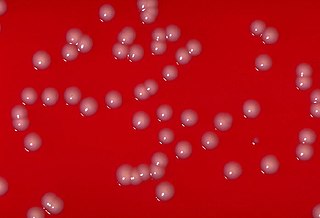Related Research Articles

Bacillus subtilis, known also as the hay bacillus or grass bacillus, is a Gram-positive, catalase-positive bacterium, found in soil and the gastrointestinal tract of ruminants, humans and marine sponges. As a member of the genus Bacillus, B. subtilis is rod-shaped, and can form a tough, protective endospore, allowing it to tolerate extreme environmental conditions. B. subtilis has historically been classified as an obligate aerobe, though evidence exists that it is a facultative anaerobe. B. subtilis is considered the best studied Gram-positive bacterium and a model organism to study bacterial chromosome replication and cell differentiation. It is one of the bacterial champions in secreted enzyme production and used on an industrial scale by biotechnology companies.

Corynebacterium is a genus of bacteria that are Gram-positive and most are aerobic. They are bacilli (rod-shaped), and in some phases of life they are, more specifically, club-shaped, which inspired the genus name.
Faecalibacterium is a genus of bacteria. Its sole known species, Faecalibacterium prausnitzii is gram-positive, mesophilic, rod-shaped, anaerobic and is one of the most abundant and important commensal bacteria of the human gut microbiota. It is non-spore forming and non-motile. These bacteria produce butyrate and other short-chain fatty acids through the fermentation of dietary fiber.
Ruminococcus is a genus of bacteria in the class Clostridia. They are anaerobic, Gram-positive gut microbes. One or more species in this genus are found in significant numbers in the human gut microbiota. The type species is R. flavefaciens. As usual, bacteria taxonomy is in flux, with Clostridia being paraphyletic, and some erroneous members of Ruminococcus being reassigned to a new genus Blautia on the basis of 16S rRNA gene sequences.
Vibrio furnissii is a Gram-negative, rod-shaped bacterium. Its type strain is ATCC 35016. V. furnissii is aerogenic (gas-producing), and uses L-rhamnose, L-arginine, L-arabinose, maltose, and D-mannitol, but not L-lysine, L-ornithine, or lactose. It has been isolated from patients with gastroenteritis, bacteremia, skin lesions, and sepsis.
Azoarcus evansii is a species of bacteria. Its type strain is KB 740T.
Helicobacter felis is a bacterial species in the Helicobacteraceae family, Campylobacterales order, Helicobacter genus. This bacterium is Gram-negative, microaerophilic, urease-positive, and spiral-shaped. Its type strain is CS1T. It can be pathogenic.
Desulfitobacterium dehalogenans is a species of bacteria. They are facultative organohalide respiring bacteria capable of reductively dechlorinating chlorophenolic compounds and tetrachloroethene. They are anaerobic, motile, Gram-positive and rod-shaped bacteria capable of utilizing a wide range of electron donors and acceptors. The type strain JW/IU-DCT, DSM 9161, NCBi taxonomy ID 756499.
Desulfitobacterium hafniense is a species of gram positive bacteria, its type strain is DCB-2T..
Roseburia intestinalis is a saccharolytic, butyrate-producing bacterium first isolated from human faeces. It is anaerobic, gram-positive, non-sporeforming, slightly curved rod-shaped and motile by means of multiple subterminal flagella. L1-82T is the type strain.
Roseburia faecis is a bacterium first isolated from human faeces. It is anaerobic, gram-negative or Gram-variable, slightly curved rod-shaped and motile. The cells range in size from 0.5-1.5 to 5.0 micrometres. M72/1(T)=DSM 16840(T)=NCIMB 14031(T)) is the type strain.
Roseburia hominis is a bacterium first isolated from human feces. It is anaerobic, Gram-negative or Gram-variable, slightly curved rod-shaped and motile. The cells range in size from 0.5-1.5 to 5.0 μm. A2-183(T) is the type strain.
Prevotella albensis, previously known as Bacteroides ruminicola subsp. ruminicola, is a species of bacterium.
Prevotella brevis is a species of bacterium.
Prevotella bryantii, previously known as Bacteroides ruminicola ruminicola subsp. brevis biovar 3, is a species of bacterium.
Citrobacter sedlakii is a species of Gram-negative bacteria. It has been described as causing human disease, but is generally found as a non-pathogenic organism in human stools.
Victivallis vadensis is a Gram-negative, coccus-shaped, bacteria found in the human digestive tract. It measures approximately 0.5-1.3 micrometers in diameter, is non-motile and chemoorganotrophic, and does not form spores. Victivallis vadensis is strictly anaerobic, as are 90 percent of the bacteria in the human gastrointestinal system.
A genus of butyrate-producing, Gram-positive anaerobic bacteria that inhabit the human colon. Named in honor of Theodor Rosebury, they are members of the phylum Firmicutes.
Anaerostipes is a Gram positive and anaerobic bacterial genus from the family of Lachnospiraceae. Anaerostipes occurs in the human gut. Anaerostipes may protect against colon cancer in humans by producing butyric acid.
Bilophila wadsworthia is a gram-negative, obligately anaerobic, catalase-positive, bile-resistant, and asaccharolytic bacillus. This bacterium is about 0.7 μm wide by 1.0–10.0 μm long in colony and the cells are pleomorphic with irregular cell walls. This bacterial species is mostly urease positive; around 75% of the strains are urease positive. Less than 0.01% of the human gut microbiota is this bacterium. B. wadsworthia is linked to various diseases and is not well known due to frequent misidentification of the bacteria. The two unique characteristics of B. wadsworthia are the utilisation of the sulfated amino acid taurine in the production of hydrogen sulfide and the rapid catalase reaction. This bacterium is vulnerable to the antibiotics: imipenem, ceoxitin, and ticarcillin, which are all β-lactam antibiotics.
References
- ↑ Sylvia H. Duncan; Rustam I. Aminov; Karen P. Scott; Petra Louis; Thaddeus B. Stanton & Harry J. Flint (October 2006). "Proposal of Roseburia faecis sp. nov., Roseburia hominis sp. nov. and Roseburia inulinivorans sp. nov., based on isolates from human faeces". International Journal of Systematic and Evolutionary Microbiology . 56 (Pt 10): 2437–2441. doi: 10.1099/ijs.0.64098-0 . PMID 17012576.